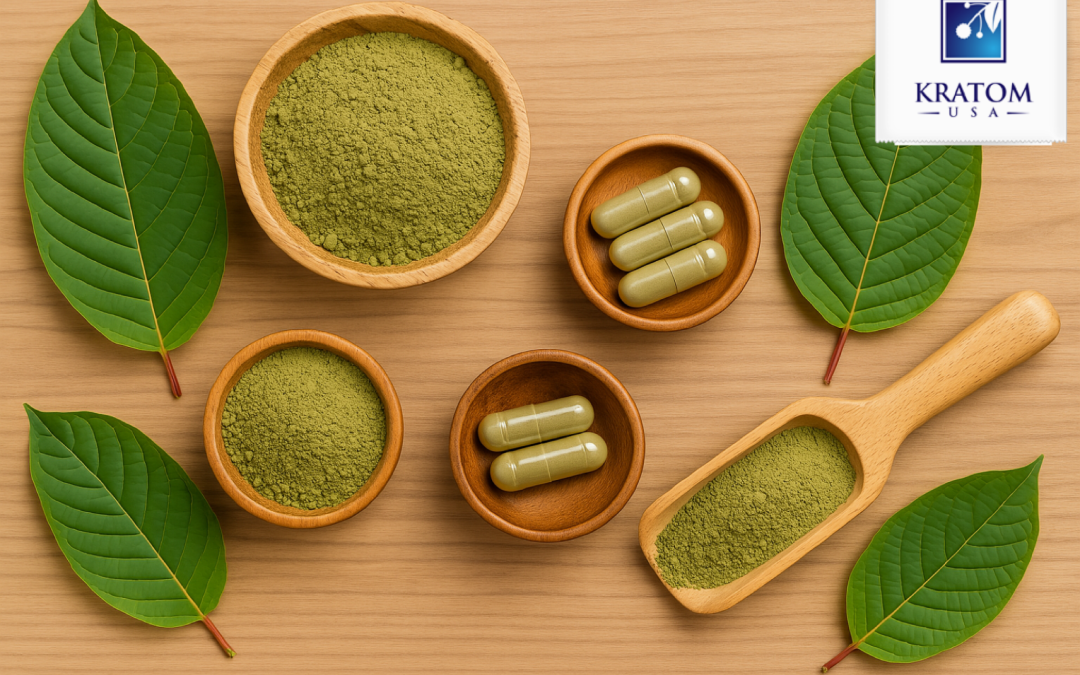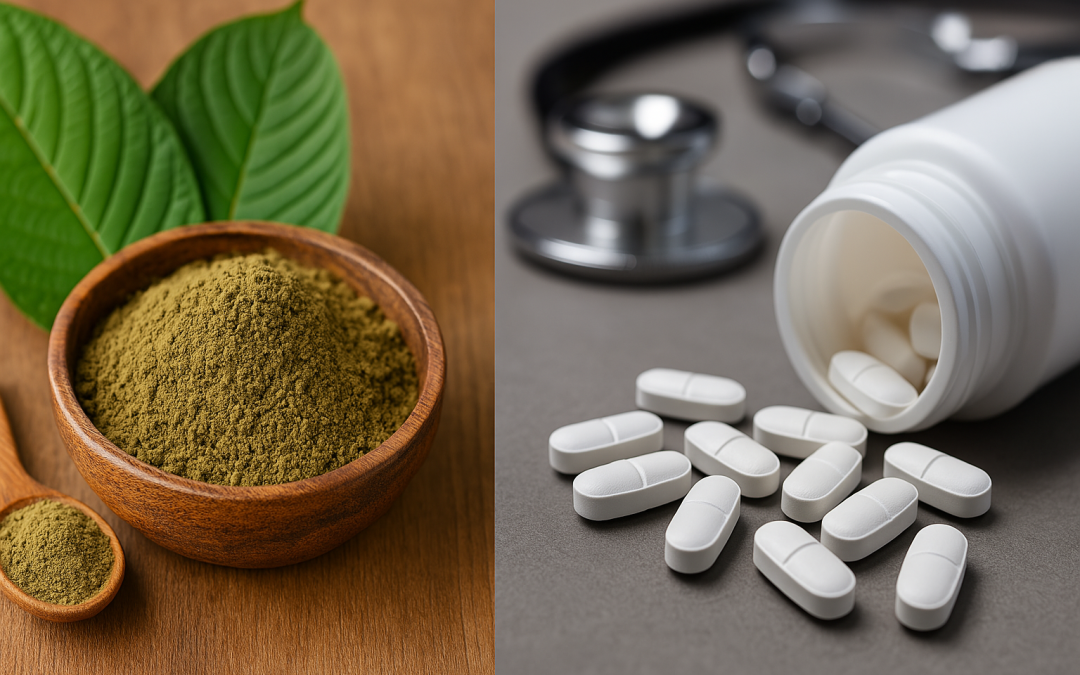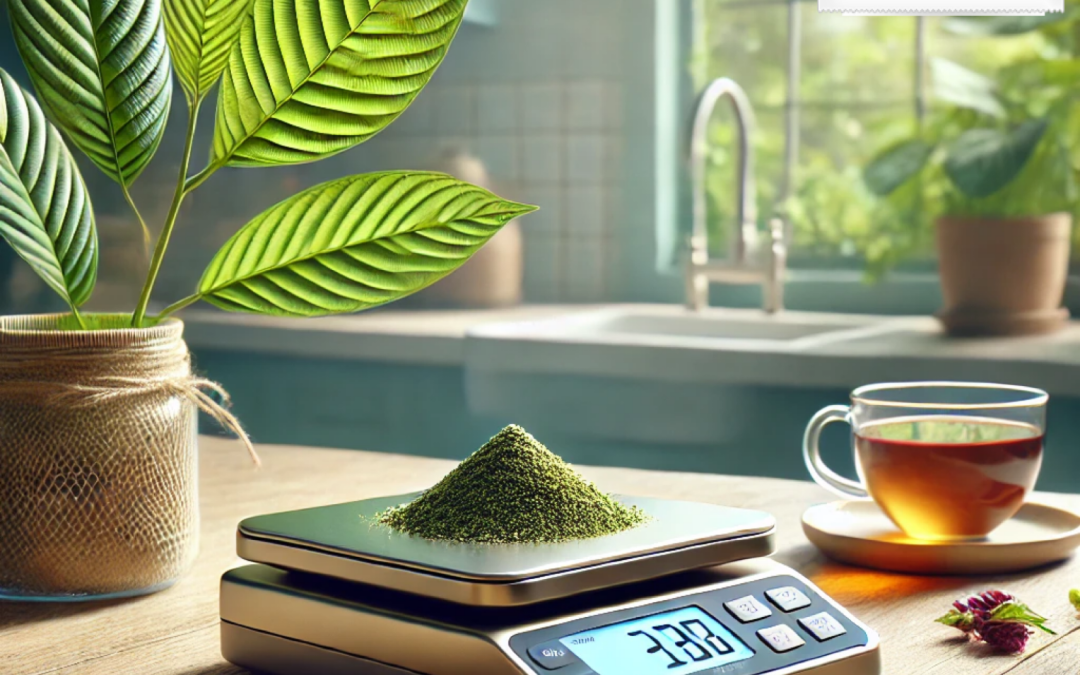
by KratomUSA | Apr 1, 2025 | Kratom
Choosing the Best Kratom Strain for Your Needs
Exploring the world of kratom can be fascinating, especially when you realize how each strain can uniquely impact your well-being. Whether you’re new to kratom or looking to refine your choices, understanding the nuances between strains is crucial. This expanded guide will delve deeper into the characteristics of the best kratom strains to help you make an informed decision based on your specific needs.
Key Points
- Boosting Energy: White Borneo and Green Maeng Da are standout strains.
- Anxiety Relief: Opt for the calming effects of Green Malay and Bali Reserve Red Vein.
- Pain Management: Red Bali and Red Vein Thai are excellent choices.
- Opiate Withdrawal Support: Green Malay and Maeng Da can offer substantial relief.
In-Depth Look at Kratom Strains
Energy and Focus
- Thai White: This strain is ideal for those needing a mental lift or an extra push to get through demanding tasks. It’s known for increasing alertness and stamina without the typical jitteriness associated with caffeine.
- Green Maeng Da: A potent strain that enhances both energy and cognitive function, making it perfect for those requiring both physical and mental stamina throughout the day.
Anxiety and Stress Relief
- Green Malay: Provides a noticeable euphoric feeling and is effective in relieving stress and anxiety while being mild enough for daily use without significant sedation.
- Bali Reserve Red Vein: Offers profound relaxation and mood enhancement, which can be particularly beneficial for those dealing with high stress or anxiety levels.
Pain Relief
- Borneo Reserve Red Vein: Known for its strong analgesic properties, Borneo Reserve is suitable for treating chronic pain such as arthritis or lower back pain. It’s effective at providing comfort without leading to daytime drowsiness.
- NPP (Natural Pain Powder): Promotes excellent pain relief and adds a soothing component, ideal for evenings or when you need relief from discomfort.
Opiate Withdrawal
- Maeng Da: Known for its strong effects, Maeng Da can alleviate withdrawal symptoms while providing a mild energy boost.
- Green Malay: Due to its long-lasting effects, it’s particularly effective for managing symptoms throughout the day, helping to reduce discomfort and enhance mood.
- NPP (Natural Pain Powder): In addition to promoting pain relief, this strain can also promote relief from withdrawal symptom and is appropriate for use during the day or night.
Detailed Usage and Dosage Guidelines
Choosing the right dosage is as crucial as selecting the strain. Here’s a brief guide:
- Low Dose (1-2 grams): Suitable for new users or those looking for mild stimulation and mood enhancement.
- Moderate Dose (2-4 grams): Ideal for achieving more pronounced relief from pain and anxiety or more substantial energy enhancement.
- High Dose (5-6 grams): Best used for significant pain relief or major relaxation needs but should be approached with caution to avoid potential side effects.
FAQs on Kratom Strains
How can I switch between different kratom strains without experiencing side effects? When switching strains, it’s best to start with a lower dose than usual to assess your tolerance and gradually adjust.
Are there any strains that help with both energy and relaxation? Green strains, especially Green Malay, are known for their ability to provide energy without sacrificing the calming effects, making them excellent for those seeking balance.
How often can I take kratom without building a tolerance? It’s recommended to space your kratom usage and possibly rotate strains to prevent tolerance build-up. Limiting use to a few times a week is best to maintain its efficacy.
Where is the best place to buy high-quality kratom? Always purchase from reputable vendors who provide detailed product descriptions and lab test results to ensure safety and quality. Kratom USA is the oldest major vendor in the US and has an outstanding reputation with a wide selection of tested and verified kratom products. They also offer an informative kratom guide that can help answer many of the most common kratom questions.
Kratom USA does not support or suggest the misuse of this product in any way. The product is for scientific and experimental purposes only. Please see our disclaimer for details.
The Food and Drug Administration has not evaluated these statements. This product is not intended to diagnose, treat, cure, or prevent any disease.

by KratomUSA | Mar 27, 2025 | Kratom
A Guide to Kratom Versus Prescription Pain Relievers
Are you navigating the maze of pain management options and curious about the differences between kratom versus prescription pain relievers? You’re not alone! Many are turning to both traditional and alternative remedies to find relief from chronic pain. Here’s a guide comparing kratom versus prescription pain relievers, packed with everything you need to know to make an informed decision.
Key Takeaways
- Kratom Pros: Non-respiratory suppressing, less addictive, accessible without a prescription, effective for mild to moderate pain.
- Kratom Cons: Less researched, potential for misuse, legal and regulatory variability, possible side effects like nausea and dependency.
- Prescription Opioids Pros: Highly effective for severe pain, dosage control and consistency, widely studied with known efficacy.
- Prescription Opioids Cons: High risk of addiction and overdose, significant side effects, potential for severe withdrawal symptoms.
Understanding How Kratom and Prescription Narcotics Work in Your Body
Kratom: A Natural Alternative
Kratom interacts with your brain’s opioid receptors much like traditional opioids, but it’s a partial agonist at these sites, primarily affecting the mu-opioid receptors. This means it can help relieve pain without some of the more severe side effects associated with narcotics, such as significant respiratory depression. This makes kratom a potentially safer option if you’re worried about the risks of overdose, as it doesn’t suppress breathing.
Prescription Narcotics: Potent but Risky
In contrast, prescription opioids like morphine and fentanyl are full agonists of the opioid receptors. They are incredibly effective at managing severe pain but come with a high risk of addiction and fatal overdose, primarily through respiratory suppression. They are the go-to option for acute and intense pain management under strict medical supervision due to their efficacy and rapid relief capabilities.
Pros and Cons Breakdown
Pros of Kratom:
- Safety Profile: Kratom does not cause respiratory depression.
- Accessibility: It’s available without a prescription, offering pain relief more accessibly.
- Flexibility: Kratom can provide energy or relaxation depending on the dose, without the severe dependency risks associated with narcotics.
Cons of Kratom:
- Inconsistent Regulation: The lack of FDA oversight can lead to variability in kratom’s purity and strength.
- Side Effects: Users may experience side effects such as nausea, constipation, and potential dependency.
- Legal Uncertainty: The legal status of kratom varies, which can affect availability and consistent use.
Pros of Prescription Narcotics:
- Strong Pain Relief: They offer powerful and reliable relief from severe pain.
- Controlled and Consistent: These drugs are regulated for quality and dosage accuracy.
- Medically Supervised: Their use is often monitored by healthcare professionals.
Cons of Prescription Narcotics:
- High Addiction Potential: There’s a significant risk of developing dependency.
- Severe Side Effects: Including potential for overdose and respiratory depression.
- Regulatory Challenges: Tight control can sometimes limit access for patients who need them most.
FAQs: Everything You Want to Know
Q: Can I use kratom for severe pain? A: Kratom is generally better suited for mild to moderate pain. For severe pain, prescription narcotics might be more effective under medical supervision.
Q: Is kratom safe to use with other medications? A: Since kratom can interact with other medications, it’s crucial to consult with a healthcare provider before starting kratom, especially if you are taking other treatments.
Q: Where can I safely buy kratom and learn more about kratom? A: Always buy kratom from reputable vendors who provide product testing and quality assurance to ensure safety and efficacy. Tips for First-Time Kratom Users is an informative guided put together by the experts at Kratom USA. With over 15 years of experience and thousands of customers, Kratom USA is a good resource for information and questions regarding anything kratom related.
Q: How do I start with kratom or prescription painkillers? A: Begin with the lowest effective dose monitored by a healthcare professional, especially when using potent narcotics, to manage pain effectively while minimizing risk.
Kratom USA does not support or suggest the misuse of this product in any way. The product is for scientific and experimental purposes only. Please see our disclaimer for details.
The Food and Drug Administration has not evaluated these statements. This product is not intended to diagnose, treat, cure, or prevent any disease.

by KratomUSA | Mar 25, 2025 | Kratom
Make Kratom Taste Better with Simple Recipes and Flavor Hacks
Kratom’s natural bitterness can be off-putting for many, but fear not! There are several fun and tasty ways to incorporate kratom into your routine without the bitter aftertaste. Whether you’re a culinary novice or a kitchen pro, these ideas will help you make kratom taste better, so you can enjoy your kratom dose with a smile.
Key Points for Enjoying Kratom
- Diverse Drink Options: Mix kratom with flavorful beverages like kratom tea enhanced with vanilla, cinnamon, and nutmeg, or try a kratom milkshake or smoothie for a delicious treat.
- Sweet and Savory Eats: Bake kratom into brownies or cookies, or blend it into energy balls and other snacks for an on-the-go option.
- Quick Fixes: Opt for kratom capsules or tinctures if you prefer a fast, taste-free experience.
Creative Recipes to Mask Kratom’s Taste
- Kratom Tea Latte: Enhance your kratom tea with sweet cream and spices like cinnamon for a cozy beverage. Adding a dollop of whipped cream can transform it into a special treat.
- Fruity Kratom Smoothies: Combine kratom with fruits, yogurt, and a splash of milk or juice to create a refreshing smoothie. Adding a bit of honey or syrup can help sweeten things up and mask the bitterness effectively.
- Decadent Kratom Desserts: For those with a sweet tooth, incorporating kratom into baked goods like brownies or cookies not only disguises the taste but also makes for a satisfying dessert.
- Savory Dishes: Mix kratom into hearty dishes like a tomato sauce to spread over pasta, which can mask the bitterness with robust flavors.
Convenient Alternatives
If you’re always on the go and need a more straightforward approach:
- Kratom Capsules: These are perfect for bypassing the taste altogether, offering a pre-measured dose without any mixing required.
- Kratom Tincture: This liquid form is potent and quick to take effect. It can be easily carried and taken with a few drops under the tongue or mixed into a drink.
FAQ Section
Q: What’s the simplest way to take kratom without tasting it? A: The toss and wash method—where you quickly swallow the powder with water—is the simplest and fastest way to take kratom without enduring the taste for too long.
Q: Can I prepare kratom in a way that actually tastes good? A: Absolutely! Mixing kratom into a milkshake or baking it into chocolate chip cookies are great ways to enjoy its benefits while indulging in something tasty. You can also make kratom syrup to sweeten drinks and foods. Check our Dr. Michele Ross’s kratom syrup recipe.
Q: Are there any quick on-the-go options for taking kratom? A: Kratom capsules are probably your best bet for convenience and taste avoidance, perfect for busy lifestyles.
Q: Where can I find more kratom recipes? A: Kratom USA offers a variety of creative recipes that can help mask the taste of kratom. Check out their full Kratom Guide and their creative kratom recipes.
By using these tips and recipes, you can turn your kratom routine into a more enjoyable and flavorful experience, making it easier to incorporate this beneficial herb into your daily life. Whether you choose to drink, eat, or quickly toss and wash, there’s a way to make kratom more palatable for everyone.
Kratom USA does not support or suggest the misuse of this product in any way. The product is for scientific and experimental purposes only. Please see our disclaimer for details.
The Food and Drug Administration has not evaluated these statements. This product is not intended to diagnose, treat, cure, or prevent any disease.

by KratomUSA | Mar 25, 2025 | Kratom
Safe Guidelines for Using Kratom During Opiate Withdrawal
Exploring natural alternatives for managing opiate withdrawal? Kratom is increasingly recognized for its potential benefits. However, navigating the use of kratom during such a sensitive time requires careful consideration of dosing and safety practices. Here’s an informative guide to using kratom during opiate withdrawal based on insights from experts at Kratom USA and the American Kratom Association.
Key Points for Safe Kratom Use
- Quality Matters: Always opt for kratom products that are well-labeled with clear information about the contents and dosing instructions. This ensures the product’s traceability and safety.
- Correct Dosing: Start with a low dose to assess your tolerance and response. Gradually adjust based on your needs without exceeding the kratom dosage guide to avoid adverse effects.
- Certified Sources: Choose products certified by independent labs to ensure they meet safety standards. Avoid products with exaggerated claims or those marketed as extremely potent.
Dosing Recommendations
When it comes to dosing, here’s what you should consider:
- Kratom Powder: Start with 2-3 grams per dose if you’re new. This amount is often enough to help alleviate withdrawal symptoms without overwhelming your system.
- Kratom Capsules: Begin with 1-2 capsules and adjust according to your response. Each capsule typically contains a precise amount of kratom, making it easier to manage your intake.
- Monitoring and Adjusting: The effects of kratom can vary significantly between individuals. Monitor how you feel after each dose and adjust slowly. This personalized approach helps minimize the risk of side effects and ensures the most beneficial experience.
Safety and Tolerance
Regular use of kratom can lead to kratom tolerance, which might reduce its effectiveness over time. To manage this:
- Take Breaks: Regular breaks from kratom can prevent your body from becoming too accustomed to it, maintaining its effectiveness.
- Stay Informed: Keep yourself updated with the latest guidelines and research from trusted sources to use kratom responsibly.
Frequently Asked Questions (FAQ)
Q: What’s the safest way to start using kratom for opiate withdrawal? A: Begin with a small dose to see how your body reacts. Consider the form of kratom that best suits your lifestyle, whether it’s capsules for convenience or powder for adjustable dosing.
Q: Can kratom usage lead to dependency? A: Like many substances that affect the brain’s opioid receptors, kratom has potential for dependence, especially with long-term use. Responsible usage, including regular tolerance breaks and appropriate dosing, helps mitigate this risk.
Q: Where can I find reliable kratom products? A: Purchase from reputable vendors who adhere to Good Manufacturing Practices (GMP). Vendors like Kratom USA offer products that are independently tested for quality and safety. For more detailed guidance, visit their website at Kratom USA.
Q: How do I know if I’m taking too much kratom? A: Signs of excessive use include needing larger doses for the same effect, experiencing negative side effects like nausea or dizziness, or psychological changes such as mood swings or irritability.
Navigating the use of kratom during opiate withdrawal with careful consideration to dosing and safety can make a significant difference in your recovery journey. Always consult with a healthcare provider before starting any new supplement, especially during sensitive periods like opiate withdrawal. For further reading on kratom’s effects and proper usage, check out the detailed resources available at American Kratom Association.
Kratom USA does not support or suggest the misuse of this product in any way. The product is for scientific and experimental purposes only. Please see our disclaimer for details.
The Food and Drug Administration has not evaluated these statements. This product is not intended to diagnose, treat, cure, or prevent any disease.

by KratomUSA | Mar 21, 2025 | Kratom
Can Kratom Promote Opiate Withdrawal Symptom Relief
Looking for a natural way to ease opiate withdrawal symptoms? Kratom could be the answer. This article explores how kratom, a natural herb, may help many people manage opiate withdrawal symptoms more gently than traditional medications.
Key Points
- Role of Kratom: Kratom is recognized for its potential to alleviate opiate withdrawal symptoms, offering a natural alternative to prescription opioids.
- Customer Testimonials: First-person accounts highlight the effectiveness of kratom in managing withdrawal symptoms.
- Kratom vs. Pharmaceuticals: Kratom is noted for not suppressing breathing, having a lower addiction potential, and causing fewer severe side effects than prescription opioids.
- Expert Source: Kratom USA, with over 15 years in the industry, provides trusted insights into the safe and informed use of kratom.
Understanding Kratom’s Potential in Opiate Withdrawal
Kratom, a botanical substance, has been increasingly acknowledged for its potential in easing symptoms associated with opiate withdrawal. This natural alternative offers symptomatic relief with a significantly lower risk profile compared to traditional pharmaceutical options.
Customer Stories: Experiencing Relief with Kratom
Bruce S. – “As someone who has navigated the challenges of opioid dependency, discovering kratom was pivotal. It provided the relief needed during withdrawal, helping me manage symptoms effectively without the harsh side effects associated with my previous prescriptions.”
Kim C. – “Post-surgery, I found myself grappling with opioid dependence. Kratom emerged as a gentle yet effective ally that eased the withdrawal process. It allowed for a smoother transition away from pharmaceutical painkillers, significantly easing my recovery path.”
Comparing Kratom with Prescription Pharmaceuticals
- Respiratory Safety: Kratom does not cause respiratory depression, a serious risk associated with many opioids.
- Addiction Potential: While kratom can lead to dependence if misused, it is generally considered less addictive than conventional opioids, offering a safer profile for those concerned about addiction.
- Side Effects: Users often report that kratom presents fewer and less severe side effects compared to opioid medications.
Backed by over 15 years of experience, Kratom USA recommends responsible kratom use, suggesting that new users start with low doses and consult healthcare professionals to customize their treatment plans effectively.
Frequently Asked Questions (FAQ)
Q: How does kratom alleviate opiate withdrawal symptoms? A: Kratom contains alkaloids that interact with opioid receptors in the brain, similar to opioids but without the high risk of severe side effects and dependency.
Q: Is kratom safe for managing opiate withdrawal? A: Kratom is considered relatively safe when used responsibly. However, it is essential to consult with a healthcare provider before beginning any new treatment, especially for individuals with pre-existing health conditions.
Q: Can kratom use lead to addiction? A: Kratom has the potential for dependence, especially with long-term use at high doses. Responsible use, including regular breaks and monitoring of consumption, is crucial.
Q: Where can I find reliable information and purchase high-quality kratom? A: Kratom USA is a reputable source for detailed information and high-quality kratom products. They offer extensive resources to help users make informed decisions about kratom use.
Kratom offers a promising alternative for those seeking to manage opiate withdrawal symptoms more naturally. With its lower risk profile compared to traditional opioids, it provides a viable option for many looking to reduce dependency on prescription medications. As with any treatment, it is essential to approach kratom use with caution and professional guidance to ensure safety and effectiveness.

by KratomUSA | Mar 20, 2025 | Kratom
The Importance of Kratom Tolerance Breaks
Kratom, a plant native to Southeast Asia, has become popular worldwide for its potential health benefits, which include pain relief, mood enhancement, and energy boosting. However, regular kratom users may develop tolerance, leading to decreased effectiveness over time. To manage this, taking regular tolerance breaks is essential. Here’s how.
Key Points
- Prevent Tolerance: Regular breaks help prevent the body from becoming too accustomed to kratom, maintaining its effectiveness.
- Health Benefits: Kratom is used for pain relief, energy enhancement, and mood improvement.
- Proper Kratom Dosage: 1-2 grams is a low dose, 3-5 grams is a standard dose, and 5 grams or above is a higher dose.
- Safety Measures: It’s crucial to use kratom responsibly and consult healthcare professionals, especially if combining it with other medications or treatments.
Understanding Tolerance Breaks
Tolerance occurs when the body becomes accustomed to a substance, and larger doses are required to achieve the same effects. Kratom users are advised to take breaks to reset their body’s response to the herb. This practice helps maintain the plant’s benefits and reduces the risk of dependency.
How to Implement Tolerance Breaks
- Schedule Regular Breaks: Incorporate regular intervals where you are not using any kratom. The length and frequency of breaks can vary depending on usage patterns and individual responses.
- Monitor Usage: Keep track of your dosage and how frequently you consume kratom. This data can help you decide when to take a break.
- Gradual Reduction: Instead of stopping abruptly, gradually reduce your kratom intake before taking a break to minimize withdrawal symptoms.
Potential Benefits of Tolerance Breaks
- Enhanced Effectiveness: Breaks can help restore the body’s sensitivity to kratom, ensuring lower doses remain effective.
- Reduced Health Risks: Regular breaks help prevent long-term adverse effects, including dependency.
- Better Overall Experience: By avoiding tolerance buildup, users can enjoy the benefits of kratom without escalating doses unnecessarily.
Proper Kratom Dosage: Understanding Limits to Avoid Excessive Use
One of the keys to using kratom responsibly is understanding the proper dosage that suits your needs without leading to excessive use. Kratom dosage can vary widely depending on the individual, the desired effects, and the specific strain used.
Guidelines for Kratom Dosage
- Beginner’s Dose: For those new to kratom, starting with a low dose is crucial. Typically, 1-2 grams is sufficient to gauge how your body reacts.
- Standard Dose: Once you are accustomed to kratom’s effects, a standard dose can range from 3 to 5 grams. This amount is often enough to experience the moderate effects of pain relief, energy, or mood enhancement without significant side effects.
- High Dose: Doses above 5 grams are considered high and are usually only recommended for experienced users who understand their tolerance levels. High doses can lead to more pronounced effects but increase the risk of side effects and dependency.
Recognizing Excessive Use
Excessive kratom use can lead to tolerance, dependence, and adverse health effects. It’s important to recognize the signs of excessive use:
- Increased Dosage Over Time: Needing progressively larger doses to achieve the same effects.
- Physical Discomfort: Experiencing symptoms like nausea, dizziness, or constipation.
- Psychological Changes: Changes in mood, sleep patterns, or irritability.
To prevent these issues, adhere to recommended dosages and take regular tolerance breaks. Monitoring your intake and being mindful of changes in how you respond to kratom can help maintain its effectiveness and minimize risks.
For more detailed guidance on dosages and to understand the full spectrum of kratom effects, visiting educational resources like Kratom USA can provide valuable insights and help ensure safe and responsible use. Always consult with a healthcare professional before starting new supplements, especially if you have pre-existing health conditions or are using other medications.
FAQ
Q: How long should a kratom tolerance break be? A: The duration can vary; some users might take a few days off, while others might need a few weeks or a month, depending on their usage patterns and personal health.
Q: Can I experience withdrawal symptoms during a tolerance break? A: Some users may experience mild withdrawal symptoms such as irritability or sleep disturbances. Gradually reducing the dose before taking a break can help alleviate these symptoms.
Q: How often should I take tolerance breaks? A: This depends on your usage frequency and dosage. Regular users often take breaks every few months to prevent tolerance buildup.
Q: Where can I find more information about safe kratom usage? A: For comprehensive guidelines on safe kratom usage and to explore different strains, visit Kratom USA, an authoritative source for information about this herb.







